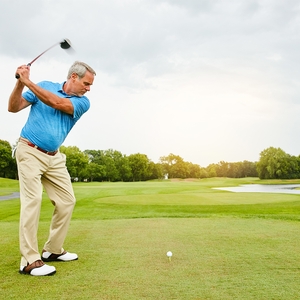Lenox Health Greenwich Village Expert Insights: 5 tips to protect your shoulders and elbows from golf injury
July 1, 2019
At first glance, golf appears to be a pretty simple sport. But any golfer knows the complex nature of a good swing and how golf’s repetitive movements can be taxing on the muscles, joints and tendons involved.
Beginners and seasoned pros are all susceptible to golf injuries. And while the entire body is affected by the stress of repetitive swings, shoulders and elbows are especially vulnerable to injury. Common shoulder and elbow ailments associated with golf injuries include:
- Rotator cuff tendonitis
- Rotator cuff tear
- Glenoid labrum tear
- Shoulder impingement
- Shoulder instability
- “Golfer’s elbow,” or inflammation in the tendons connecting the forearm to the elbow
- Osteoarthritis

Luckily, there are some ways you can protect your shoulders and elbows from pain or injury. Some of them include:
- Practicing form and posture: Poor form plus repetitive movement is a recipe for injury in any sport. If you’re a beginner, consider taking golf lessons so you can get the hang of the mechanics of the proper swing. Taking lessons may be a small investment upfront, but it could save you time and money in the long run by perfecting your form and posture and protecting your body from harmful movements.
- Warming up and stretching: Before you play, perform some warmup exercises to encourage blood flow and to prepare your body for more intense movement. It’s important to warm up and stretch the whole body, but pay special attention to your rotator cuff, wrists and forearms to prevent shoulder and elbow injuries. However, don’t neglect your core and lower body! Enhancing your flexibility through active stretching will not only help to prevent injury, but it may also improve your overall game.
- Conditioning your body for the game: Ease into the game before jumping into extended play times—especially if you’re a beginner or recovering from an injury. Condition your body to the strain of the sport by working up to longer sessions. Proper conditioning also means staying hydrated and well-nourished both on and off the course. Listen to your body and call it quits if you start feeling pain or discomfort.
- Weight training: Training the muscles surrounding your joints and tendons will go far in preventing shoulder and elbow injuries. Stretching and strengthening the forearms, for example, is one way to avoid the infamous “golfer’s elbow,” in which forearm muscles and tendons are damaged from overuse.
- Resting, and getting help, when you need it: If something feels off, consider taking a break. Rest your muscles and joints, and use plenty of ice and compression to keep any swelling down. If pain persists for longer than a couple of weeks, or if you feel immediate, excruciating pain, contact your doctor.
The key to preventing long-term problems is to address any minor injuries right when they occur. If you have shoulder or elbow pain, consider reaching out to us for a consultation and our expert advice on what treatment plan might be right for you.
An expert in sports medicine, Etan P. Sugarman, MD specializes in the treatment of athletes of all abilities, from high school to professional players to weekend warriors. To learn more about Dr. Sugarman and the orthopedic practice at Lenox Health Greenwich Village please call 646.741.5324 or click here.

